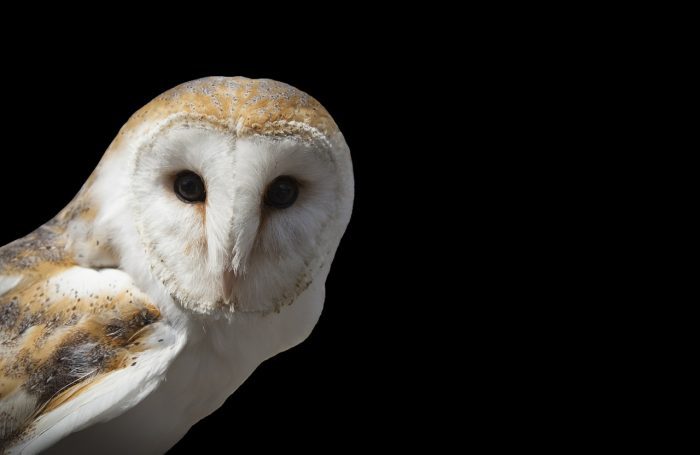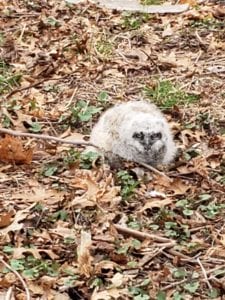By John L. Turner

I stepped out the back door into the clear and bracing evening air, under the inky black dome of the night sky pockmarked with the stars in the constellation of Orion and the luminous planetary dot of Venus to the southeast. Within a few seconds I hear a call: several deep hoots of a Great Horned Owl, repeated three more times in quick succession. It’s a sequence that one ornithologist characterizes as: “Who’s awake, me too!” While I couldn’t see it, I suspected the bird was hooting from a large white pine on the south side of the neighbor’s yard and its presence filled me with excitement as it always does when hearing or seeing an owl.
Several species of owls, varying in abundance, seasonality, and habitat, can be found on Long Island; some nest while a few don’t breed on Long Island but overwinter, while still others migrate through the island. In addition to the Great Horned Owl, they include the Screech Owl, the winter visiting Snowy and Short-eared Owls, and the uncommon Long-eared and Saw-whet Owls. Frequenting barns and other structures is the strikingly beautiful Barn Owl. A very rare winter visitor, having visited just a few times in the past century, is the stunning Great Grey Owl, associated with more northerly latitudes. Currently, ornithologists have documented 254 owl species globally.
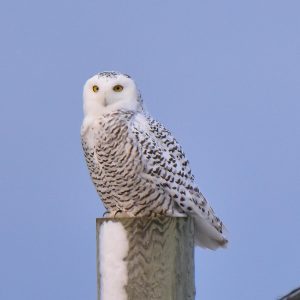
Perhaps the most coveted owl to lay your eyes on is the Snowy Owl, which possesses a snowy white plumage in adult male birds. Adult females and immature birds of both sexes have black flaking. This species is an open country bird, preferring the windswept habitats of its breeding range — open dunes and heathland and, unlike most owl species, is active during the day.
The south shore barrier islands, including Jones Beach and Robert Moses State Parks, can be fruitful areas to look for this diurnal species. As for a search image, think a white paper bag situated atop a dune crest. Driving the stretch of Dune Road from Shinnecock Inlet west to Cupsogue County Park is also worthwhile.
Snowy Owls appear almost every winter in a still not fully understood response to prey abundance in the Arctic. It used to be thought the movement of the species southward was tightly correlated with a decrease in abundance of their prey, lemmings. The phenomenon is not that clear cut and scientists aren’t fully sure what drives their long and stressful southbound journeys.
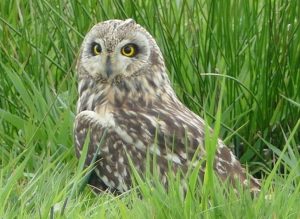
The Short-eared Owl is another species associated with open country that’s active during the day. Short-eared have an infinity for grasslands, meadows, and marshes. This species was once an uncommon breeding bird; it is now quite rare, if it still breeds here at all. The best bet to see this handsome species is as an overwintering bird probably at the former Grumman property in Calverton. The grassy margins of the formerly used runways support small mammals like mice and voles which the owl feeds on. Short-eared can also be occasionally viewed perched on telephone poles along Dune Road.
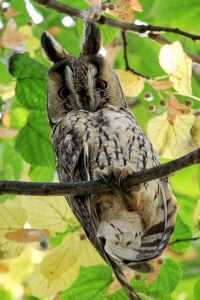
The closely related Long-eared Owl is uncommon on Long Island and if it breeds here at all it is in very low numbers. It is seen most often as an overwintering bird, typically perched in conifers or evergreens. One of my fonder memories involving this group of birds was seeing, many decades ago, several Long-eareds perched together in evergreen shrubs first found by fellow birders and friends Bob McGrath and Rich Gostic, on an estate property on the east side of the Nissequogue River. Based on the pellets and white wash it was clear the roost had been used for some time. Unfortunately, the estate was developed in the 1980’s and the owl patch destroyed.

In my youth I worked at the 133-acre Hoyt Farm Preserve in Commack. For many years a pair of Barn Owls nested in the old wooden tower that once provided water for the farm. A highlight for me and other staff was to periodically climb the metal rungs of the ladder to gain entry into the tower and band the young owls. During the banding process they would hiss loudly along with their parents, comically rocking their heads back and forth. Unfortunately, as the land around the preserve was developed, there apparently wasn’t enough habitat to sustain an ample prey base needed to sustain the pair of barn owls and their young, as they haven’t nested at the preserve in many decades.
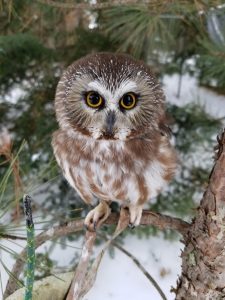
The Northern Saw-whet Owl is perhaps the least known of our native owl species. It is also the smallest, topping out at about eight inches from top of head to tail tip and tipping the scales at less than three ounces. (In contrast, the aforementioned Snowy Owl weighs about four pounds). The Saw-whet’s name derives from the fact its call sounds a bit like the sound made when whetting or sharpening a saw. This diminutive bird has a preference for tangles — vines and tightly growing pine branches — where it hides during the day. It has been recorded as breeding on Long Island although it is seen much more often during fall migration and as an overwintering bird. Want to see the definition of cuteness? Take a look at a photograph of a fledgling Saw-whet. Oh my!
Both the Great Horned Owl and its diminutive cousin the Screech Owl are woodland birds. Both species have ‘horns’ which are really vertical feather tufts, as does the aforementioned Long-eared; they play no role in defense or hearing.
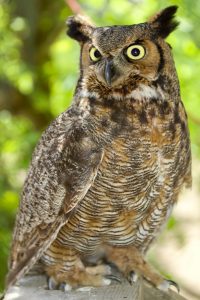
The Great Horned Owl is the earliest nesting bird and at the time this article appears adults will be incubating eggs, providing them with life-giving heat. Several years ago I was checking out a wooded Town of Brookhaven preserve in Holbrook when I saw what I thought was a white plastic bag partially hidden behind an oak tree. Coming around the tree I was startled to see not a bag but a wet Great Horned owl fledgling sitting amidst the damp leaves. I knew if there was one fledgling there were likely more and after some searching I found two other fledglings, one of which, perched on a fallen pine tree, was already growing into its adult plumage. An adult perched in a live upright pine tree nearby kept a steady eye on both me and her precocious babies.
The Screech Owl is probably the most common and widespread owl species found here with breeding pairs likely inhabiting most woodlots five to ten acres or larger. Like the Saw-whet, Screech Owls are cavity nesters, using holes excavated in trees by woodpeckers. Unlike almost all of the other eighteen North American owl species, the Screech owl is polymorphic, a fancy term meaning the species has three color morphs or forms — a grey plumage form, a rufous colored one and a form intermediate (which I have never seen). Of the several dozen screech owls I’ve had the pleasure of seeing on Long Island, I’ve only seen the rufous morph although I’ve seen the grey form a few times in other places.
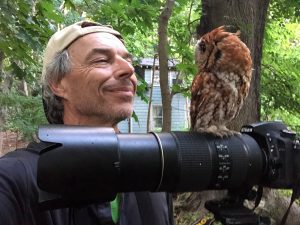
The most well-known Screech Owl on Long Island undoubtedly is Alfie, made famous through Carl Safina’s wonderful book Alfie & Me, in which, in part, he describes the trials and tribulations of nursing a very sick Screech Owl fledgling back to health, assisting with her successful re-wilding, and watching her blossom into a devoted parent, raising, to date, 15 young in the woodlands in and adjacent to his Setauket residence.
Screech owls are misnamed — rather, the ‘screech’ title belongs to the Barn Owl, which emits a haunting sounding hiss or screech when agitated or disturbed. Screech owl vocalizations, which I occasionally hear in my backyard and on the hikes around Long Island, aren’t screechy at all; indeed they are rather pleasant sounding — a two parted horse like whinny followed by a pulsing whistle. I encourage you to listen to a recording of its call.
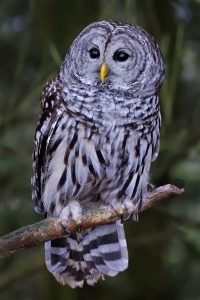
A puzzle regarding the presence of owl species on Long Island is the dearth of Barred Owls. This species, well-known for its distinctive “Who-cooks-for-you?, Who-cooks-for-you-all?” call is very rarely heard or seen here. This is a bit surprising since the species is fairly common in areas north and west of the island such as southern Connecticut and northern and central New Jersey. Its scarcity might be due to the fact that it prefers large, extensive tracts of forested wetlands such as tupelo-red maple swamps and these areas on Long Island are rarely more than a couple dozen acres in size at most.
Owls are well adapted to being “denizens of the dark.” They possess exceptional vision and hearing and have feathers that dampen or eliminate sound as they fly. Owls see quite well in the dark, an obvious necessity for a nocturnal lifestyle.
One reason is the size of their eyes. Great-horned Owls have large barrel-shaped eyes they cannot move, so to change its field of view an owl must turn its head. Another reason is due to the abundance of rod cells in their eyes which help them to detect light; they have about 50% more rods than we do. Lastly, owls have forward facing eyes enabling binocular vision, like us, which helps with depth perception, a key attribute when hunting prey that is small, mobile and fast. Their forward facing eyes is what imparts the ‘wise’ look unique to owls.
Their hearing is remarkably acute as well due to the fact their ear openings are asymmetrically positioned on each side of the owl’s head. This allows for an owl to not only detect if a mouse is rustling to its left or right (the vertical plane) but whether it’s on the ground or in a bush a few feet off the ground (the horizontal plane). Experiments with Barn owls in totally dark situations proved this species can successfully capture prey using hearing alone.
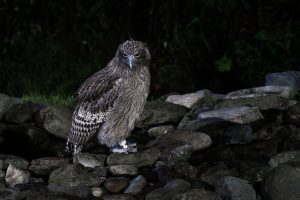
The leading edge of an owl’s flight feathers is “fluted” which creates a soft edge that muffles sound, rather than a hard or straight edge like in a duck or seagull. This feature enables silent flight, a great advantage to a bird, gifting it the element of surprise. Interestingly, owl species like the Blakiston’s Fish Owl, the largest owl in the world, that feed on species that cannot detect the sound of an owl, like fish, lack the fluted edge. No need to evolve silent flight when your prey can’t hear you to begin with.
A good way to acquaint yourself with this remarkable and charismatic group of birds is to join a local Audubon chapter or Sweetbriar Nature Center on an organized nocturnal “owl prowl” or venture out to the Calverton Grasslands or Jones Beach to see one of the species active during the day. If you do and are lucky enough to hear or see an owl I bet you’ll be filled with excitement too!
A resident of Setauket, author John L. Turner is a naturalist, conservation co-chair of the Four Harbors Audubon Society, and Conservation Policy Advocate for the Seatuck Environmental Association.

